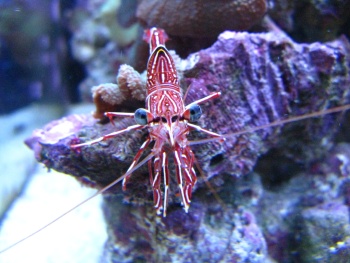
By Bob Goemans

Not Reef Tank Suitable
Likely Fish-Only Tank Suitable
Range: Indo-West Pacific Ocean
Size: 1.5 - 2.0 inches (4 cm)
Natural Environment: Inhabits shallow rocky inshore areas and are often found in caves or crevices, under overhangs, and holes in coastal reef structures.
General Husbandry: Occasionally available in the home aquarium trade.
First and foremost, this is not a good choice for the reef aquarium, as they will feed upon coral polyps, besides scavenging for other available foods.
In general, this is a species that will seek out hiding places and rarely be seen during daylight hours. It's not necessary to feed them, as they hide mostly by day, usually on the underside of elevated rocks, and scavenge/feed during the night. Yet shrimp pellets, dropped in their vicinity, usually just prior to the systems lamps shutting down for the day will help somewhat in preventing them from nibbling on coral polyps, especially one of their favorites - zoanthid polyps. They will also take other meaty foods, e.g., frozen brine/mysis, fish and shrimp flesh, and some dried meaty foods.
Taxonomy:
Kingdom: Animalia
Phylum: Arthropoda
Class: Malacostraca
Order: Decapoda
Family: Rhynchocinetidae
Genus: Rhynchocinetes
FYI: This species, one of approximately 17 in this family, can be identified by its white 'Y-shaped' mark on its top forward-central body area.
Better maintained in small groups of 3 - 5 specimens.
Basically, unsuitable for the reef aquariums.
Experience Level: Intermediate
Diet: Carnivore
Temperament: Peaceful
Aquarium Environment: Fish-only aquarium
Coral Safe: No
Fish Safe: Yes
Invertebrate Safe: Yes
Acclimation Time: Shrimp are 'very' sensitive to specific gravity/salinity changes. Therefore, be sure to adjust the bag's water to that of the aquarium in which it will be placed by slowly adding small amounts of aquarium water to the bag every few minutes. In most cases, this process should take at least 15 minutes.
Aquarium Hardiness: Moderately hardy
Calcium (Ca): 380 - 430 mg/l
Alkalinity: 2.5 - 3.0 meq/l
Phosphate (PO4): <0.05 mg/l
Magnesium (Mg): approx. 1350 mg/l (relate to specific gravity) Extremely important for molting!
Strontium (Sr) 8 - 10 mg/l
Iodine (I) Trace element additives containing iodine should be used as recommended by their makers, as iodine is also vital for the molting process.
Temperature Range: 68 - 79°F (20 - 26°C)
Minimum Tank Size: 30 gallons
Lighting: PAR ratings N/A
Water Movement: WM 1 - 2
Specific Gravity: 1.023 - 1.025
pH: 8.0 - 8.4

.jpg)